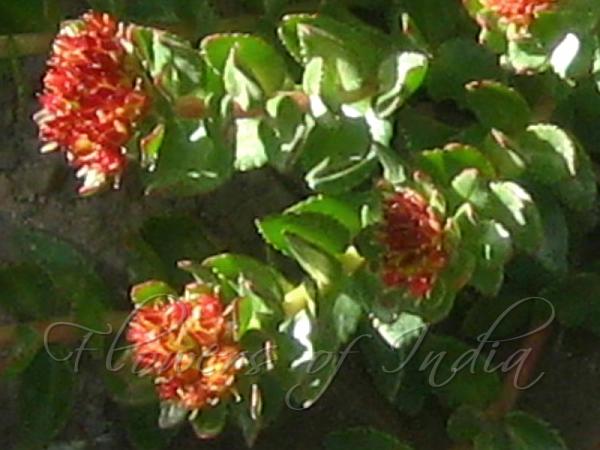|
| Scalloped-Leaf Roseroot |
|

|

| File size | 125825 |
| Original date | 8/26/13 10:34 AM |
| Resolution | 800 x 600 |
| Flash | Flash did not fire, auto |
| Focal length | 6.6mm |
| Exposure time | 1/400s |
| Aperture | 3.0 |
| Focus Distance | |
| Metering Mode | Center weighted average |
| Camera make | Canon |
| Camera model | Canon PowerShot A495 |
| Sensor type | OneChipColorArea |
|
|
|
|
Photo: |
Botanical name: Rhodiola crenulata Family: Crassulaceae (Sedum family)
Synonyms: Rhodiola euryphylla, Sedum crenulatum, Sedum rotundatum
Synonyms: Rhodiola euryphylla, Sedum crenulatum, Sedum rotundatum
Scalloped-Leaf Roseroot is a perennial herb with stem
few branched, short, 5-20 cm. Caudex leaves scalelike,
inverted-lanceshaped, 1-2 cm, tip somewhat pointed. Sterile branches
are erect, 4-17 cm, at tip densely leafy; leaves broadly obovate, 1-3
cm. Flowering stems are numerous, erect or flabellate, straw-colored to
red, 5-20 cm; leaves shortly pseudostalked. Leaves are elliptic-oblong
to nearly round, 1.2-3 x 1-2.2 cm, margin entire and wavy to rounded
toothed, tip blunt to with a short sharp point. Flowers are borne in
corymbs, about 2 x 2-3 cm, many flowered, bracteate. Flowers are
shortly to long stalked, unisexual, large, male ones unequally
5-merous. Sepals narrowly triangular, lanceshaped, or oblong, 2-3.5 mm,
tip blunt to subblunt. Petals are red to purplish red,
inverted-lanceshaped, 6-7.5 x 1-1.5 mm, tip blunt. Stamens are 10,
equaling petals, styles short. Female flowers are similar but stamens
absent and carpels equaling petals. Fruits are erect, red when dry,
8-10 mm. Scalloped-Leaf Roseroot is found in thickets, grassland
slopes, rocky places, rock crevices, at altitudes of 2800-5600 m, from
the Himalayas to China. Flowering: June-September.
Medicinal uses: Scalloped-Leaf Roseroot has
been used for many years in Eastern traditional medicine for a variety
of medicinal purposes and is particularly described in Pharmacopoeia of
China. It has been widely used to prevent acute mountain sickness in
the Himalayan areas.
Scalloped-Leaf Roseroot has
been used for many years in Eastern traditional medicine for a variety
of medicinal purposes and is particularly described in Pharmacopoeia of
China. It has been widely used to prevent acute mountain sickness in
the Himalayan areas.
Medicinal uses:
 Scalloped-Leaf Roseroot has
been used for many years in Eastern traditional medicine for a variety
of medicinal purposes and is particularly described in Pharmacopoeia of
China. It has been widely used to prevent acute mountain sickness in
the Himalayan areas.
Scalloped-Leaf Roseroot has
been used for many years in Eastern traditional medicine for a variety
of medicinal purposes and is particularly described in Pharmacopoeia of
China. It has been widely used to prevent acute mountain sickness in
the Himalayan areas. | Identification credit: Krishan Lal | Photographed at Rohtang Pass, Himachal Pradesh. |
• Is this flower misidentified? If yes,